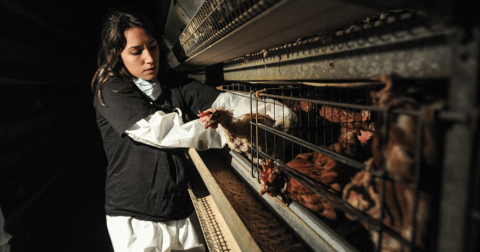Feature
How America’s Largest Meat Company Leverages Palantir’s Surveillance Tech
Food•10 min read
Explainer
The tactic of rescuing injured farm animals has helped animal rights activists win more court cases and nab the media spotlight.


Words by Jessica Scott-Reid
Animals are considered property. Under most legal systems — whether we’re talking about a chicken, a lab rat or your goldendoodle — the law treats them as something of value rather than a person with rights. In practical terms, that means if you remove an animal from its owner’s possession without permission, the law considers it stealing.
But if the animal is injured, ill or otherwise suffering, that could change its status, or at least that’s the argument behind a relatively new tactic called “open rescue.” The animal rights activists who use this strategy argue that there is a legal right to save an animal — any animal — in need of help.
The first case of open rescue took place in 1993, when Australian activist Patty Mark was provided footage from a local egg farm, showing the animals living in cruel conditions. When authorities refused to do anything about the mistreatment, Mark went on to the property. In addition to documenting what she saw, Mark also offered aid to the animals — calling what she did “open rescue.”
“Those early open rescues by Patty and her group Animal Liberation Victoria triggered international attention and put farm animals front and center in animal rights,” writes Direct Action Everywhere (DxE) activist Wayne Hsiung, who is currently on trial for an open rescue in Sonoma County in Northern California.
In 1999, Mark then spoke to the United Poultry Concerns’ Forum on Direct Action for Animals, in Virginia, inspiring a new wave of American grassroots activists to start entering farms to seek out sick and suffering farm animals in need of care. By 2003, says Hsiung, “the movement for open rescue had gone viral.” The Washington Post covered the open rescue group Compassion Over Killing (COK) that same year.
During a typical open rescue, animal activists simply walk onto farms and remove animals showing signs of distress. In order to prepare, DxE offers training to would-be open rescuers — a six module course that includes a virtual simulation of what it’s like to enter a factory farm and rescue animals.
Walking onto farms is done openly, without masks, without violence and without property damage. Showing your face is a requirement, signaling to the public that activists have nothing to hide, that they believe what they are doing is right, “and that we are normal people,” says long-time activist Jenny McQueen, also with DxE (among other groups). The hope there is that some members of the public might relate to the volunteers. “It normalizes that it’s okay to go in and to take animals from these awful places,” she adds, “it’s really shining a light on the horrors within.”
Open rescuers also document the conditions of the farms they enter. They might live stream what they find or record it for later use, in an effort to counter meat industry claims that the norm is a farm where animals are healthy and cared for. Often the rescued animals are provided veterinary care and relocated to sanctuaries.
Sharing stories of rescued animals is also an important aspect of open rescue. Many are given names, says McQueen. “People are used to having animals in their homes and naming their cats and dogs,” says McQueen. “If we name the animals within these places, hopefully [the public] gets to see that they are not property, they are individuals with their own personalities,” she says.
Finally, open rescue activists keep the sanctuary location secret, in order to ensure their long-term safety.
Perhaps the most well-known case of open rescue involves two piglets, Lily and Lizzie. Ill and underweight when they were found by activists at a Smithfield-owned (the largest pork producer in the U.S.) facility in Utah, Circle Four Farms, the pigs were rescued by activists and relocated to animal sanctuaries, which the FBI then raided in search of the pigs’ DNA.
Five activists with the group DxE were arrested after the open rescue, and ultimately charged with felony burglary and misdemeanor theft. At trial, two of the five activists faced five and a half years in prison. Hsiung, who is an attorney, represented himself arguing to the jury that the two pigs were similar to dogs in hot cars, since in some jurisdictions, dogs in that scenario can be legally rescued without legal consequences.
The jury ultimately acquitted the two remaining defendants (three others took a plea deal by the time the case went to trial) revealing in subsequent interviews that the prosecution’s case failed because the animals — who were ill and therefore unlikely to be processed into food anyway — did not have any monetary value for the farmers. No value, no theft. “They just let a guy who walked into a factory farm and took two piglets out without the consent of Smithfield walk out of the courtroom free,” said Hsiung outside the courthouse that day. “If it can happen in southern Utah, it can happen anywhere.”
Most cases of open rescue have turned out in favor of rescuers, at least so far. In Canada, for example, McQueen has used an open-rescue strategy to save numerous animals, including an unspecified number of pigs from a London, Ontario hog breeding farm in 2018.
One of the pigs, later named Noel, was suffering from a damaged ear. In that case, she explains to Sentient, “I wanted to take it all the way to trial,” but then, “the [government] prosecution dropped all the charges a few days before the actual trial.” Even with video evidence clearly showing McQueen walking out the farm with a pig, government lawyers decided there was little chance of conviction. “I think public opinion is completely for the activists,” says McQueen. “When they see a cute animal in a person’s arms, I don’t think they want to go ahead with the trial.”
The concept of open rescue is not without criticism, including from critics within the animal advocacy community. Activist Jake Conroy for example, posted his concerns regarding open rescue to his Instagram account The Cranky Vegan, characterizing it as “glorifying” prosecution. Conroy himself spent time in prison for his activism. “I don’t think it’s something we should encourage or use as a media gimmick or incorporate into our strategies,” he writes, citing in-part the high risk involved, potential release conditions that activists may face and the immense financial cost of fighting such cases.
There has also been legal backlash. In Canada for instance, lawmakers passed legislation that fines anyone who trespasses onto a farm to film or otherwise document the conditions there. These so-called “ag-gag” laws substantially increase financial penalties for undercover work, and can even include jail time for those who trespass into agricultural operations. The laws work to deter activists, as well as whistleblowers, undercover investigators and journalists, from exposing the industry.
Other advocates question the effectiveness of direct action tactics. Annie Lowery recently reported on the divide in the movement for The Atlantic: “Over time, the animal-rights movement came to focus more on incremental change than on disruption, and more on institutional pressure than on individual persuasion.” Campaigns put pressure on companies to improve welfare standards for laying hens and pregnant pigs in their supply chains, and by all accounts they made headway — close to 90 percent of companies lobbied by The Humane League’s Open Wing Alliance to transition to cage-free eggs have fulfilled their commitments, for instance.
More recently, a number of animal advocates have made the case that the movement for farm animals benefits from both strategies — direct action interventions and animal welfare campaigns.
Trial remains underway for Hsiung as the remaining activist from DxE, facing two felony conspiracy charges and two misdemeanor trespass charges. Three defendants were charged by Sonoma county prosecutors — one defendant was dismissed and another took a plea deal — after entering three factory farms and removing and providing medical care to 70 chickens and ducks.
At trial, the defendants have presented the judge and jury with disturbing images and videos of birds, some with injuries and some dead, stuck in their cages unable to move or access food and water.
The group has also recently created the #ProsecuteMe challenge as a call to action on X (the social media channel formerly known as Twitter), “highlighting how ridiculous it is to criminalize compassion for animals.”
Open rescue has become a popular tool for animal rights activists to challenge the legal status quo for farmed animals. While criticism of the tactic persists, and in some cases subsequent ag-gag laws may ultimately make the situation for animals and rescuers more difficult, advocates point to legal victories and life saving rescues as their motivation to continue forward.
This piece has been corrected: There is only one remaining defendant in the Sonoma County trial (Wayne Hsiung) and two (not five) defendants were acquitted in the Smithfield case (three others took a plea deal).